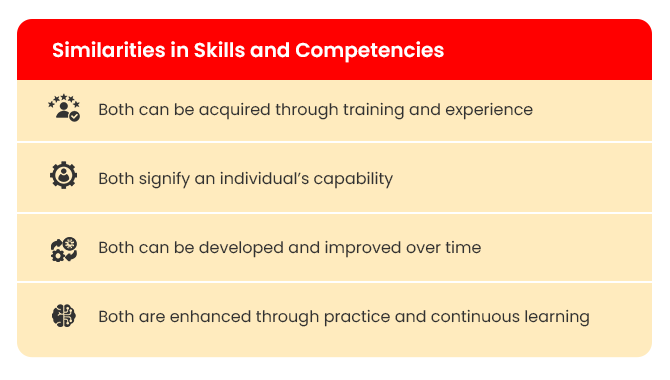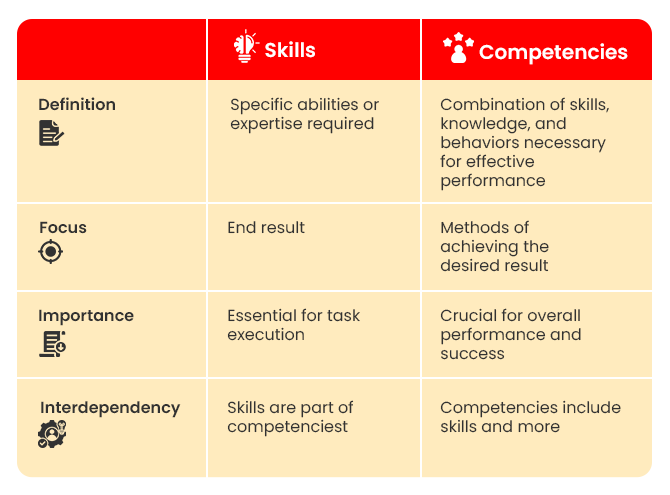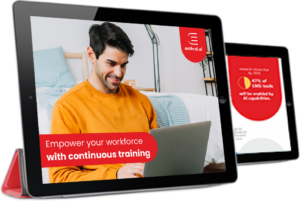What’s the Difference Between Skills and Competencies?

Employees frequently receive advice that they need to enhance their skills and increase their competency in their roles to move ahead professionally. What happens next? Most end up mistaking skills and competencies as the same.
But let me drop a truth bomb here. No, skills and competencies aren’t the same! Many mix up skills and competencies like they are twins or something. But really, they aren’t. You could maybe say they are like cousins, but that’s it. 🙂
This confusion arises because the terms sound pretty similar. The misunderstanding is often also rooted in a lack of clear understanding and communication.
In this blog, I shall delve into the difference between skills and competencies. We will also look at how organizations can leverage this understanding to create a framework that can be invaluable to upskill or reskill their employees.
What is Skill?
A skill is the capacity to accomplish a specific objective in a particular context. It can be acquired through experience or formal training and it can evolve from basic proficiency to intermediate or expert levels.
Essentially, skills address the “what” as in what is the intended outcome? For example, consider a situation where you are using a specialized software for creating a funky design for say a birthday party invite. Now, you will need to have a basic understanding of the software interface to navigate it, so that you can efficiently complete your task.
Skills aren’t just cognitive. They can also be practical, such as fixing a leaky faucet or assembling a piece of furniture.
In professional contexts, we often distinguish between hard and soft skills. Hard skills are concrete and quantifiable, such as expertise in software programming. Soft skills, on the other hand, are qualities that are associated with emotional intelligence, such as patience or active listening.
What is a Competency?
A competency, on the other hand, merges skills with knowledge and behavior. It offers a broader perspective than mere skill.
We can look at competencies as the ‘how’: how do you achieve a desired outcome?
Let us relook at the earlier scenario of using a specialized software for design. A basic proficiency in using the software was enough to create that invite. Now, imagine you work as a designer in a company. Here you are likely to need a higher level of proficiency in using that software, understanding it in the context of design principles and knowing how to adapt to different project requirements. Over here, you aren’t just skilled in using the software. You need to demonstrate competency as a professional capable of delivering high-quality design work.
Also Read: The What, Why and How of a Skills Taxonomy for Learner Upskilling
How are Skills and Competencies Similar?
Skills and competencies share similarities in that they can both be acquired through training and experience, and they both signify an individual’s capability.

How are Skills and Competencies Different?
As previously discussed, skills can be likened to the end result while competencies represent the methods of achieving that result. Therefore, while employees need specific skills to excel in their roles, they also exhibit competencies that dictate how they execute their tasks, including skills, knowledge and behaviors.
But how are skills and competencies different from each other? To understand this better, let’s consider an example of a chef in a busy restaurant kitchen. Mastering cooking is undeniably an essential technical skill. However, this technical skill alone cannot guarantee success in a restaurant kitchen.
This is where competency becomes crucial. Imagine a chef who can flawlessly execute complex recipes but struggles to handle high-pressure situations during peak dining hours. In such instances, the ability to remain composed under stress, effectively manage time and communicate with the team becomes key. Even contributing to a positive work environment and collaborating seamlessly with colleagues are invaluable positives in ensuring smooth kitchen operations.
This example also highlights that skills and competencies are interdependent. For instance, when a busy restaurant is hiring its next chef, proficiency in culinary techniques is undoubtedly a top priority. However, the ideal candidate must also possess additional hard skills such as knowledge of food safety regulations and inventory management. They will also need competencies like teamwork, adaptability and leadership to excel in a high-pressure kitchen environment.

Which Is More Important?
Both skills and competencies play important roles in an employee’s development. Without certain skills relevant to their position, employees cannot effectively demonstrate competencies. To progress in their careers, employees must continuously enhance both their skills and competencies.
The onus is on organizations and L&D teams to strike a balance between building competencies and honing skills when grooming employees for future roles. Focusing solely on skills may result in well-equipped employees who lack the essential intangible qualities required for key positions.
By clarifying these terms, L&D and HR teams can create an alignment between employees and managers on areas for improvement, ultimately reducing turnover rates and enhancing employee engagement.

Empower your workforce with continuous training
- Employee Onboarding
- Employee Upskilling
- Compliance Training
Establishing a unified understanding of skills and competencies within your organization encourages the growth of more capable employees. Also, this shared clarity removes any confusion internally and externally on skills and competencies. Nurturing both skills and competencies among employees ensures that your organization can effectively fill critical roles in the future.
Should You Use Competencies or Skills?
Given the subtle differences between the two models, a platform like Enthral can accommodate whichever approach aligns with your organization’s preferences.
If your company has been relying on a competency system since long and you aren’t ready to transition away from it, that is okay. You can still enhance standardization, organizational flexibility and experiential learning by focusing on skills. Maintaining your current model while simultaneously mapping skills to job roles can yield many of the same benefits as adopting a skill-based approach.
Ultimately, the method you choose should be tailored to fit your organization and its people. Ensure that your model can effectively assess your workforce, narrow in on areas for their development and provide suitable learning opportunities that will help their professional growth.
Wrapping Up
Understanding the difference between competencies and skills is an effective way to pinpointing skills gaps among employees. By identifying the competencies necessary for current and future roles, organizations can effectively isolate areas where employees lack essential skills.
This information provides a clear starting point for reskilling or upskilling initiatives to prepare individual employees for roles. Additionally, it also justifies the necessity for greater investment in the company’s learning and development initiatives.








